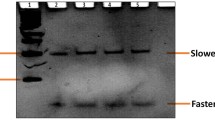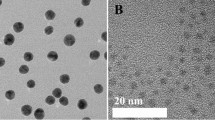Abstract
A versatile fluorescence scaffold was constructed by connecting a G-triplex sequence (G31) with G-rich DNA (aptamer of kanamycin) and using thioflavin T (ThT) as the fluorescent molecule. With the assistance of an aptamer, the G-quadruplex DNA structure was fabricated using G31 as three strands and the aptamer as the fourth strand. Due to the parallel planar morphology of the final products, which was favorable for ThT binding and which restricted the rotation of the aromatic rings of ThT, the fluorescence signal intensity of ThT was significantly enhanced. Because of the specific interaction of aptamer and kanamycin, in addition to the greater ability for kanamycin to bind with G-triplex than ThT, the conformation of G-quadruplex DNA was changed; in addition, ThT was dissociated from the aptamer-G31, and therefore a ‘turn-on’ to ‘turn-off’ detection principle was applied for kanamycin detection, which yielded reasonable sensitivity and selectivity. The detection range was 50–2000 nM, with a limit of detection of 1.05 nM. Our proposed method was thus successfully applied for kanamycin determination in pork, chicken, and beef samples, and satisfactory results were obtained.





Similar content being viewed by others
References
Hu H, Ung COL, Wang Y, Geng Z, Peng Y, Xue Y. Metal–organic frameworks (MOFs) based analytical techniques for food safety evaluation. eFood. 2021;2(1):1.
Wang C, Tan R, Li J, Zhang Z. Exonuclease I-assisted fluorescent method for ochratoxin A detection using iron-doped porous carbon, nitrogen-doped graphene quantum dots, and double magnetic separation. Anal Bioanal Chem. 2019;411(11):2405–14.
Wang C, Chen D, Wang Q, Wang Q. Aptamer-based resonance light scattering for sensitive detection of acetamiprid. Anal Sci. 2016;32(7):757–62.
Wang C, Chen D, Wang Q, Tan R. Kanamycin detection based on the catalytic ability enhancement of gold nanoparticles. Biosens Bioelectron. 2017;91:262–7.
Song KM, Cho M, Jo H, Min K, Jeon SH, Kim T, et al. Gold nanoparticle-based colorimetric detection of kanamycin using a DNA aptamer. Anal Biochem. 2011;415(2):175–81.
Xing YP, Liu C, Zhou XH, Shi HC. Label-free detection of kanamycin based on a G-quadruplex DNA aptamer-based fluorescent intercalator displacement assay. Sci Rep. 2015;5:8125.
Preu M, Guyot D, Petz M. Development of a gas chromatography-mass spectrometry method for the analysis of aminoglycoside antibiotics using experimental design for the optimisation of the derivatisation reactions. J Chromatogr A. 1998;818(1):95–108.
Patel KN, Limgavkar RS, Raval HG, Patel KG, Gandhi TR. High-performance liquid chromatographic determination of cefalexin monohydrate and kanamycin monosulfate with precolumn derivatization. J Liq Chromatogr Relat Technol. 2015;38(6):716–21.
Oertel R, Neumeister V, Kirch W. Hydrophilic interaction chromatography combined with tandem-mass spectrometry to determine six aminoglycosides in serum. J Chromatogr A. 2004;1058(1-2):197–201.
He JX, Wang Y, Zhang XY. Preparation of artificial antigen and development of IgY-based indirect competitive ELISA for the detection of kanamycin residues. Food Anal Methods. 2016;9(3):744–51.
Zhu ZM, Lin XY, Wu LN, Zhao CF, Zheng YJ, Liu AL, et al. "Switch-On" fluorescent nanosensor based on nitrogen-doped carbon dots-MnO2 nanocomposites for probing the activity of acid phosphatase. Senso Actu B-Chem. 2018;274:609–15.
Wang S, Zhao J, Lu S, Sun J, Yang X. A duplex connection can further illuminate G-quadruplex/crystal violet complex. Chem Commun. 2019;55(13):1911–4.
Guo YH, Yao WR, Xie YF, Zhou XD, Hu JM, Pei RJ. Logic gates based on G-quadruplexes: principles and sensor applications. Microchim Acta. 2016;183(1):21–34.
Wang C, Dong X, Liu Q, Wang K. Label-free colorimetric aptasensor for sensitive detection of ochratoxin A utilizing hybridization chain reaction. Anal Chim Acta. 2015;860:83–8.
Lv L, Li D, Liu R, Cui C, Guo Z. Label-free aptasensor for ochratoxin A detection using SYBR Gold as a probe. Sensors Actuators B Chem. 2017;246:647–52.
Zhou H, Wu ZF, Han QJ, Zhong HM, Peng JB, Li X, et al. Stable and label-free fluorescent probe based on G-triplex DNA and thioflavin T. Anal Chem. 2018;90(5):3220–6.
Ma L, Han X, Xia L, Kong RM, Qu F. A G-triplex based molecular beacon for label-free fluorescence "turn-on" detection of bleomycin. Analyst. 2018;143(22):5474–80.
Wang CK, Wang CG, Wang QQ, Chen D. Resonance light scattering method for detecting kanamycin in milk with enhanced sensitivity. Anal Bioanal Chem. 2017;409(11):2839–46.
Kong D-M, Xu J, Shen H-X. Positive effects of ATP on G-quadruplex-heminDNAzyme-mediated reactions. Anal Chem. 2010;82(14):6148–53.
Wang C, Wang X, Chan H-N, Liu G, Wang Z, Li H-W, et al. Amyloid-beta oligomer-targeted gadolinium-basedNIR/MR dual-modal theranostic nanoprobe for Alzheimer's disease. Adv Funct Mater. 2020;30(16):1909529.
Guo YH, Sun Y, Shen XQ, Zhang KC, Hu JM, Pei RJ. Label-free Detection of Zn2+ Based on G-quadruplex. Anal Sci. 2015;31(10):1041–5.
Wang C, Liu D, Wang Z. Resonance light scattering as a powerful tool for sensitive detection of beta-amyloid peptide by gold nanoparticle probes. Chem Commun. 2011;47(33):9339–41.
Guo Y, Xu L, Hong S, Sun Q, Yao W, Pei R. Label-free DNA-based biosensors using structure-selective light-up dyes. Analyst. 2016;141(24):6481–9.
Gao J, Liu Q, Liu W, Jin Y, Li B. Comparative evaluation and design of a G-triplex/thioflavin T-based molecular beacon. Analyst. 2021;146(8):2567–73.
Acknowledgements
This study was funded by the National Natural Science Foundation of China (21305032), China Postdoctoral Science Foundation (2014M551522) and Jiangsu Planned Projects for Postdoctoral Research Funds (1402073B).
Author information
Authors and Affiliations
Contributions
C. Wang contributed to the design of the experiments, data analysis and manuscript preparation. J. Li performed the experiments.
Corresponding author
Ethics declarations
Competing interests
The authors declare that they have no competing interests.
Additional information
Publisher’s note
Springer Nature remains neutral with regard to jurisdictional claims in published maps and institutional affiliations.
Supplementary Information
ESM 1
(DOCX 188 kb)
Rights and permissions
About this article
Cite this article
Wang, C., Li, J. Fluorescence method for kanamycin detection based on the conversion of G-triplex and G-quadruplex. Anal Bioanal Chem 413, 7073–7080 (2021). https://doi.org/10.1007/s00216-021-03676-y
Received:
Revised:
Accepted:
Published:
Issue Date:
DOI: https://doi.org/10.1007/s00216-021-03676-y




